
In early 2020, Netflix sent out an update that confused and upset many of its customers. Suddenly, some 167 million Netflix subscribers had to deal with an autoplay feature that automatically began shows if the user hovered over a movie while deciding what to watch. The move perturbed users, and Netflix eventually apologized and added an option to turn off the auto-play feature. (Alexander, 2020). It’s unknown whether Netflix had analytical data telling their design team that most of their users would prefer autoplay or not. Still, many saw the move to be a blunder that hurt user experience, something frequently shorthanded to UX.
Autoplay wasn’t a practical choice for many of Netflix’s subscribers. When designing a product, Marcus’ mantra is “Practical. Purposeful. Profitable.” If your product is practical and you are able to convey the purpose of it, nine times out of ten, it will also be profitable. Find out how focusing on perfecting your user experience will help your company grow, become more successful, and turn your average customer into a brand ambassador.
Designing For User Experience Means Designing To Be Profitable
Do you remember your last great meal out? The one where the food was terrific, the conversation was lively, the decor was perfect for the occasion, and your server was funny and helpful? You had a great user experience. Too often, UX tends to focus on the tech world, relating only to websites and apps, but it can and should be focused on all sorts of businesses. Customers and their happiness are the lifeblood of small businesses.
At its core, user experience means taking into account what customers want, need, and value. It means realizing that your older clients might not know how to navigate a crowded website filled with millennial jargon. Similarly, it means keeping up with industry trends that competitors are using to stay on top of the market. It serves clients and customers first, with an eye on fulfilling your company’s objectives. Designing for user experience will build loyalty, break down purchase barriers, and ultimately make your company more profitable and healthy.
Here’s Why Putting User Experience First Will Always Be Good Business
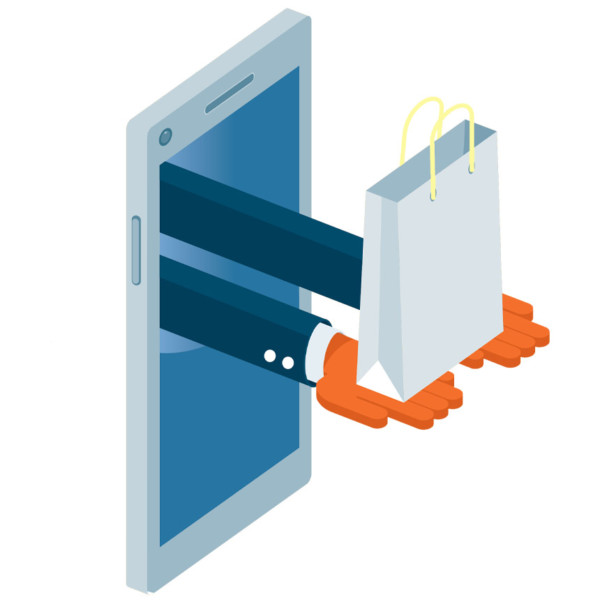
It’s critical in today’s age.
When customers were limited to shopping in their local towns and cities, they had limited options to shop. The Internet was a great equalizer. People can now browse thousands of shops to find the best deals and the easiest-to-use digital storefronts.
When a small business puts clients’ needs first, they’re setting themselves up for repeat business and a better reputation.
It builds customer loyalty.
Top-notch UX means that customers aren’t counting the minutes they have to spend in your store or on your website to check out. When a customer has fun exploring while feeling comfortable, they’re much more likely to return. Retention creates lifelong revenue, and that’s a reliable way to run a business. Simplicity is the key. Don’t burden your clients with too many bells and whistles. Take a page from Google. When the Internet was in its infancy, Yahoo, AltaVista, and Lycos were kings. Slowly, their homepages became hubs of news, email alerts, stock market information, and more. Google cut through the extras and provided a simple white page with a search bar and two buttons. Now, they own 94% of the search engine market share. (Shaw, 2020). Loyalty built the Google empire, and it did it through simplicity and innovation.

It maximizes ROI and conversions.
When a customer in your store or on your website does what you want them to do, be it purchase an item, sign up for a newsletter, or give you a new sales lead, you’ve made a successful conversion. Something as simple as a slow payment system or a glitch-ridden menu bar can turn customers away. When that happens, the hard-earned cash you spent on advertising promotions goes down the drain. By prioritizing user experience, you’ll have a more significant return on investment and make more conversions.
It will increase efficiency.
Designing your business around a better user experience does two critical things in regard to efficiency.

First, it streamlines and cuts out unneeded information. Customers can tell when someone tries to make their store or website look more important and busier than it is. As Marcus says, “People respect you more if they get the truth as opposed to a bunch of fluff.” Secondly, good UX also gets rid of any roadblocks users and clients may face. If you’ve ever been shopping and wanted to ask an employee a question about a product but found yourself unable to locate a help station, then you know the frustration of feeling lost because of bad UX. Online, you want to build an intuitive place where customers will implicitly know how to navigate themselves through your site. That’ll make them feel better while shopping longer.
It keeps customers satisfied.
Satisfied customers are more likely to become brand ambassadors. These people go out of their way to sing your praises and bring in new business. There’s a quote often attributed to Henry Ford that says, “If I had asked people what they wanted, they would have said faster horses.” A good user experience not only gives customers what they want, but it delivers it in a way that seems perfectly natural and intuitive, so issues or inconveniences won’t even occur to them. A satisfied customer won’t know the hard work that created a satisfying experience, but they will appreciate the result.
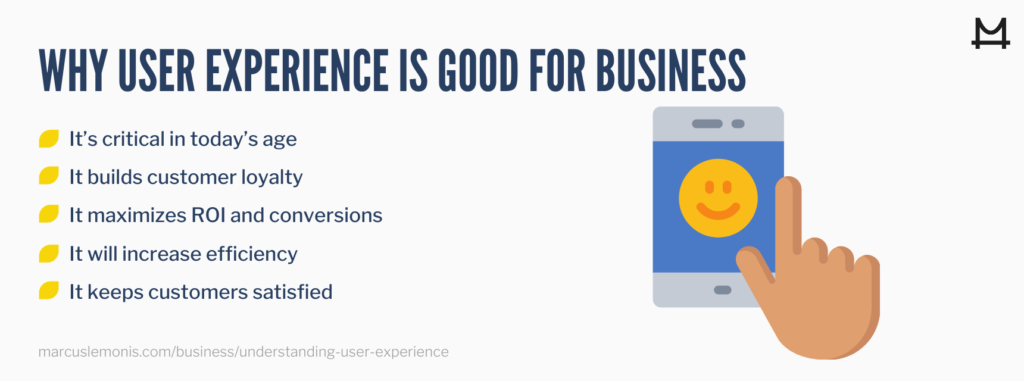
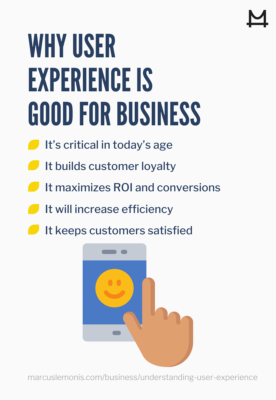
Focus On These Areas To Build a Better User Experience
1. Project management.
A project manager’s job isn’t to deliver a website or a storefront for you; it’s to provide an efficient website or storefront that works for customers. Make sure your project managers keep user experience in mind on every new project. When it’s overlooked in the design, construction, or sales phase, it’s hard to retrofit a good UX into something that already exists.

2. Client research.
If you’re wondering when the right time is to do user research, the answer is yesterday, no matter where you are in your business journey. The sooner you do, the more bearing the information you discover will have on your success. Moreover, small-business owners and entrepreneurs would be wise to keep the research stage going permanently, arming themselves with as much information as possible. Demographic trends shift, customers lose interest, and technology advances faster in some areas than others. Companies that aren’t monitoring their user experience based on client makeup and demographics won’t be prepared to shift along with those changing winds.
Remember what Marcus says. “In any business, you can’t be complacent. If you do, you’re going to go backwards.”
3. User interface design.
What the heck does that mean? Simply put, it’s how easy your store or website is to navigate for every kind of user. When your interface design is good, customers won’t even notice it. It will just feel natural and easy. When it’s bad, you’ve got a world of hurt coming your way. Negative impressions last a lot longer than good ones. Creating a simple space to navigate, where it’s easy to find answers and is unchallenging for all users, is the recipe for success. For example, you can spend thousands of dollars and countless working hours building a great website, but have you thought about how it loads differently on Android cell phones vs. iPhones? Laptops vs. desktops? Good interface design is about making sure every customer positively experiences your company.
4. Think about your virtual design.
When thinking about the ideal user experience, don’t forget about your employees. If you have people working remotely (almost a given considering the Covid-19 pandemic), then spend a little time considering how they communicate with one another.

Phone calls and sticky notes passed between coworkers used to be a great way to get business done, but there are tons of virtual tools on the market that can enable your employees to share files, build presentations, and chat in real-time online. When you design your office communication in a way that suits everybody, whether they’re in-office or remote, then everybody will benefit. So when thinking about virtual user design, take your staff members’ needs into consideration. Remember what Marcus says, “The customer is not No. 1 to me. They’re No. 2, right behind the employee.”
5. Content strategy.
Focus on what’s essential to put in front of clients right now. Suppose someone logs onto your website looking to buy a $3 item. In that case, they shouldn’t have to slog through your company history before finding the product page, no matter how impressive your company’s history is (and we’re sure it is). Tuning into your customer needs is crucial for building a good user experience. Your goal is to create an easily browsable store that is tailor-made for your specific clients. You should put the right information in front of the right customers at the right time.
6. Analytics.
Don’t stop listening to your customers. Many companies can run diagnostics on your business to give you the insight to design a better product. Whether customers know it or not, they’re leaving a trail of breadcrumbs every time they shop with you. Online, they leave information like how long they waited to click the purchase button. In-store, their in-and-out time can tell you how well-designed your sales floor is. If you aren’t analyzing that information, then you might not know when you have a problem on your hands. As the old saying goes, “You can’t manage what you can’t measure.”
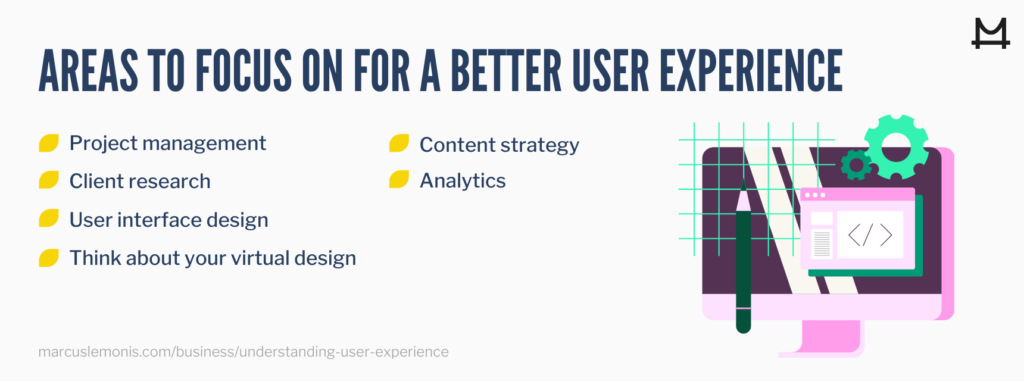
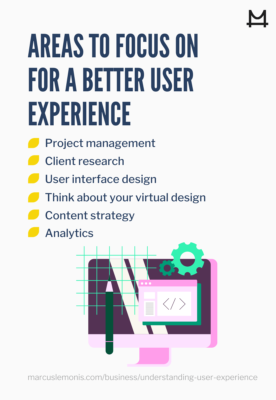
How To Create Results Through a Great User Experience
Keep your branding consistent.
From your in-store display designs to your website’s color palette, keep all of your branding consistent. Your company and its brand should be easy to find and recognize, even after making little design tweaks. Unless something is catastrophically wrong, try not to redesign your brand completely.

Use clear calls to action.
Simply put, a call to action is a sign or a phrase that instantly engages a customer and makes them do something. It should be small, engaging, bright, and enticing.
A few notable calls to action are: “Now ½ price,” “Start your free trial now,” “Buy now,” and “Order online.” For e-commerce sites, beginning your call to action with verbs associated with shopping is best (buy, purchase, get, take).
Always focus on customer needs.
To create a great user experience, put yourself in your customers’ shoes. Ask yourself what their goals are, what problems they have that you can solve, what are they interested in, what they believe, and what inspires them to purchase. For example, take Uber, the ridesharing app. Uber saw a problem. Calling for cabs was a hassle. Sometimes they wouldn’t show, or they’d show up late. You didn’t know who was driving. And, bad reviews for rude drivers didn’t add up to much change.

Uber put their customers’ needs first, streamlined the hailing process, made a simple-to-use app, and changed the way people move around the world. The company has faced issues in the past few years, but their UX isn’t one.
In the 11 years since they launched, they have been part of a wave that turned the taxi and limousine market from a locals-only industry to a global enterprise, and they’ve taken over 12.75% of the market, the largest share of any company in the game. (Business Research Company, 2020).
Explore user behavior.
A small tweak to any part of your UX will make ripples in your customer pool. By examining those ripples and figuring out how it changed user behavior, you can figure out where to focus your attention. A customer needs motivation, ability, and a trigger to make a purchase. If they come to your site or store, they already have motivation. If they aren’t there, focus on how to bring them in. If a customer picks up an item or adds it to their online cart, but then they choose to leave, figure out why. Do you need to lower your prices or offer discounts? Or, did they find your payment page confusing? Finally, customers need a trigger to make a purchase. Are your calls to action strong and clear? Do your clients feel comfortable waiting for a better deal? To provide a good user experience, your company has to explore user behavior.
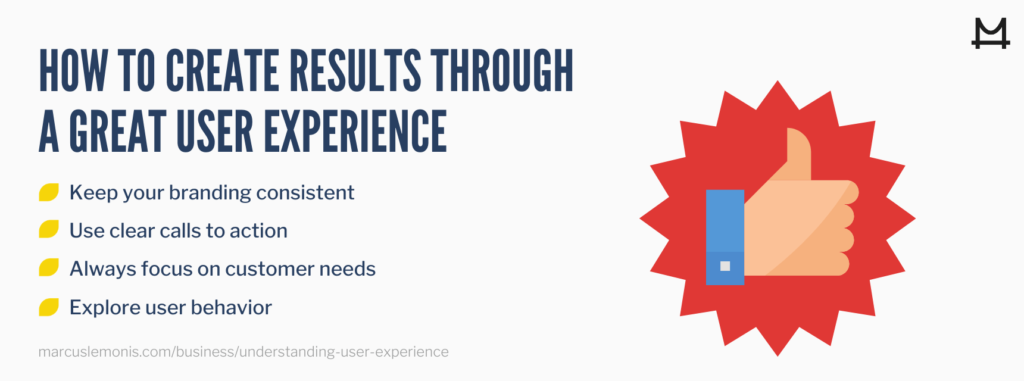
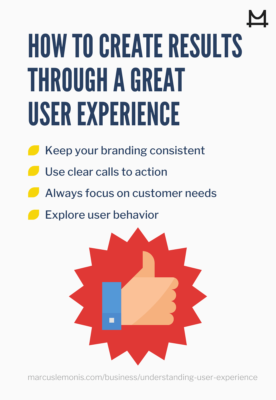
Put Yourself In Your Customers’ Shoes
Building better user experiences is crucial because it makes your customers happy. It’s as simple as that. How it makes them happy and why it makes them happy is a bit more complicated, but at the end of the day, it’s an entrepreneur’s job to cater to their clients. Create a brand that pleases, products that wow, and tools that don’t distract from their enjoyment. You can do that by listening to their feedback and tracking the way they shop with you. In the end, it’s all data and numbers. And, as Marcus says, “If you don’t know your numbers, you don’t know your business.”
- How do you build your user experience?
- How does user experience benefit your business?
Alexander, Julia. (2020, Feb. 6). Netflix will now let you disable its awful autoplaying feature. https://www.theverge.com/2020/2/6/21126867/netflix-autoplay-feature-disable-homepage-episodes-series
Business Research Company. (2020, Nov. 25). Uber Rides Unchallenged In The Top Spot Of The Global Taxi And Limousine Market. https://www.globenewswire.com/news-release/2020/11/25/2133871/0/en/Uber-Rides-Unchallenged-In-The-Top-Spot-Of-The-Global-Taxi-And-Limousine-Market.html
Shaw, Mike. (2020, Jun. 15). why google is the best search engine (and why businesses should care). https://www.towermarketing.net/blog/google-best-search-engine/#:~:text=It’s%20believed%20that%20Google’s%20success,stand%20out%20from%20the%20competition.&text=Google%20provides%20simple%2C%20better%20results.





